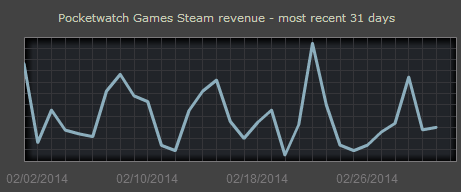Steam, Humble Bundles and sales cannibalization
For the longest time, I’ve wondered if Humble Bundles and Steam sales were hurting or helping the video games industry. There’s not a lot of data about this on the Internet but some indie gamemakers were kind enough to share some numbers on their blogs.
-
Jason Rohrer, explained in a post why he was refusing to participate in Steam Sales. He also gave a couple figures and graphs about his sales.
-
The creators of Dustforce, Hitbox Team, did a year in review post. Dustforce was featured in the Humble Indie Bundle 6. It seems to have made a pretty okay year.
-
PocketWatch Games – whose game Monaco was in last month’s Humble Bundle – wrote a postmortem.
In this post, I’ll try to show why I think Steam sales and bundles are mostly a good thing for video games developers.
A warning: this is mostly going to be some wild speculation, with a few facts peppered here and there. Also, it gets pretty hand-wavy toward the end.
So, do sales and bundles affect negatively the revenue of indie game makers? It would be tempting to think this. After all, there’s like five sales a year, so people may be holding on their money waiting for the next steam mega-sale/humble bundle.
I don’t think it’s true, though. Last week, the Monaco team revealed their day-to-day sales during the humble indie bundle 11 (it ran from February 18 to March 4).

It looks like they made a huge number of steam sales during the humble bundle. Don’t forget there’s 65 million steam users. The humble indie bundle 11 sold 493,000 copies. It’s probably hard to imagine this in the Internet Echo Chamber, but bundle buyers are a tiny portion of steam users. Steam probably makes the equivalent revenue of a bundle daily.
But, I can already hear you “But Karim, this is a humble bundle. It has five games in it. There’s like five steam mega-sales a year, with almost the whole steam catalog. Surely, people must be keeping their money for the big sale just around the corner.”
Again, I don’t think it’s true. The graph below is Dustforce’s net income for 2012:

There’s two interesting things:
-
The curve has roughly the same slope before and after the Steam Midweek Madness. This means to me that most people who bought dustforce then weren’t planning to get it. Of course, there could be some potential sales cannibalization, but since the sale was so short – only three days, and with 20,000 dollars in profits – I doubt it was significant.
-
Just before the humble bundle the sales have almost tappered off. Again, this could be because of cannibalization, but this would be weird. This is probably just because five months after its release, the game has slipped from public consciousness. The bundle comes, and of course there’s a massive uptick in sales.
During the two months period between the bundle and the steam sales, sales are quite good for a six-month old game with almost no promotion. And yet some people would have held on their money waiting for the next big sale, without knowing if Dustforce would be part of the sales? That’s like the definition of people who don’t really want to buy your game.1
What if instead, the people who bought the game during the steam sale weren’t really wanting to get it?
Steam sales are a great thing for game developers. There’s thousands of choices on the steam store. Valve knows nobody will buy every game, so they figured out the best way to get people to buy more games: making them impulse purchases. That’s why there were four big sales last year.2
It works great. How many people have played more than half of the games in their Steam library?
So yeah, Steam sales are a great thing.
Key takeaway: If you’re an indie developer, you should do Steam Sales.
-
By the way, because of the way Steam sales are organized (almost no sales during the first half of the year and three to four sales in the last six months), it’s probably better to launch a game at the beginning of the year. This way, you can make good sales at the start and use the steam sales to regain some popularity when sales dry up. ↩
-
This is market segmentation at work. Sales target buyers who are looking for bargains. There’s a specific submarket of gamers who are okay with playing a game a few years old if they bought it for a lower price. ↩